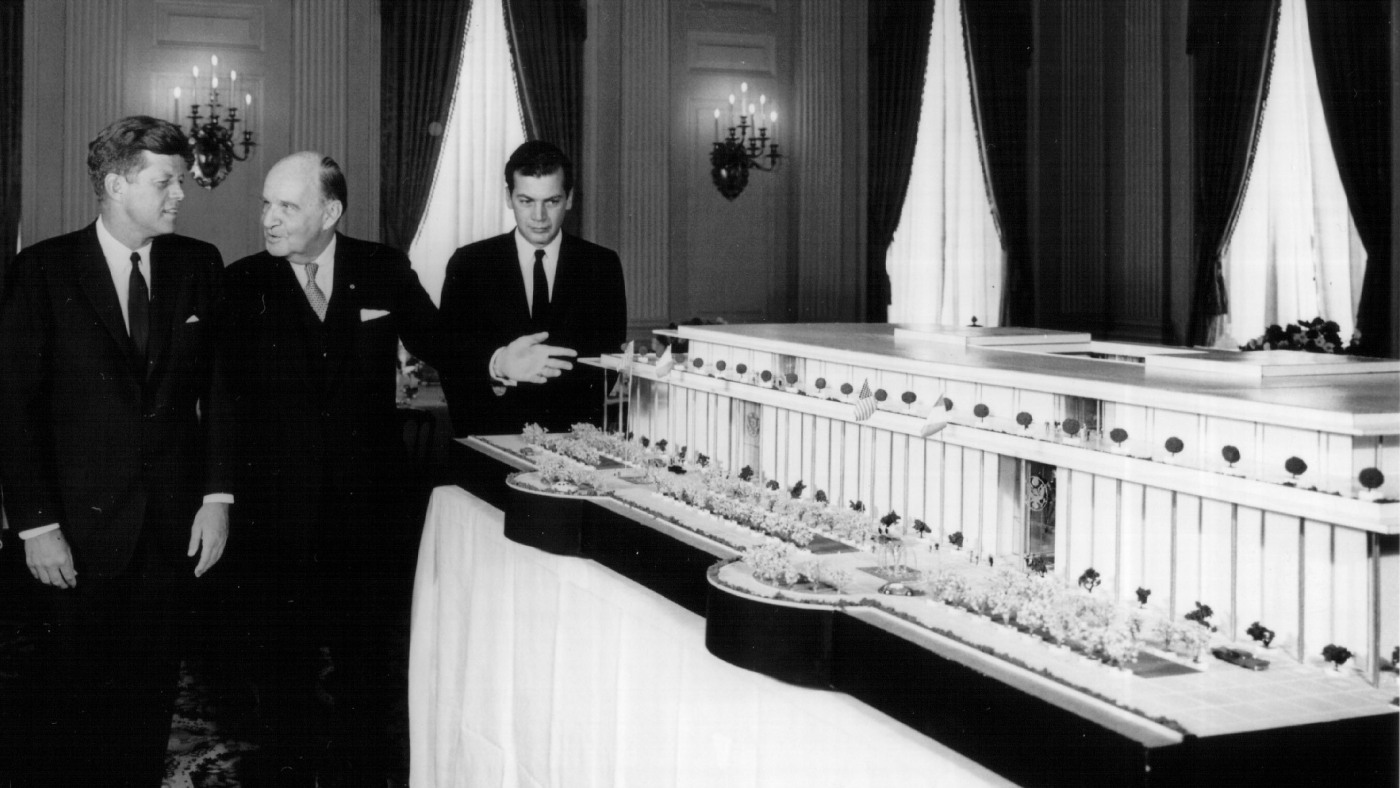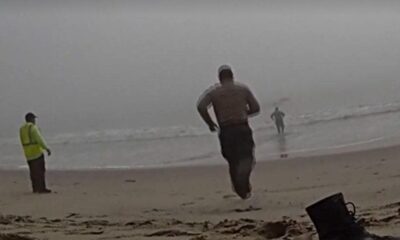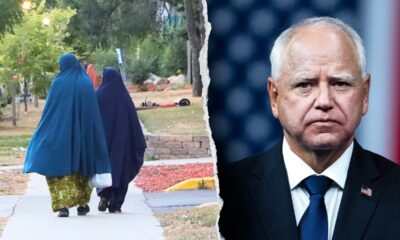Lifestyle
Aztec Rebels: La travesía de un club de motociclistas Latinos encontrando un hogar en el Bronx

Jossiel Estefes, apodado “Onex“, se encuentra junto a su motocicleta en una estación de gasolina en Connecticut, durante un paseo el 17 de marzo de 2024.
Mayolo López Gutiérrez
hide caption
toggle caption
Mayolo López Gutiérrez
“Mira lo que construiste, comenzamos con cuatro cabrones y ahora mira esto”, dijo Sergio García, el Sargento de Armas, a Andrés Lucero, señalando la fiesta llena de gente, con niños corriendo por todas partes y mujeres charlando en una de las mesas.
Andrés no respondió, pero sus ojos lo decían todo: el orgullo de ver su sueño hecho realidad, rodeado de amigos que se habían convertido en familia.
Era la cena de Thanksgiving, la celebración Acción de Gracias en el sur del Bronx en Nueva York. Los hombres traían puestos chalecos de cuero, emblemáticos del club Aztec Rebels, con los ojos puestos en la reunión.

Andrés Morales, fundador y ex presidente del club, posa junto a los miembros del club durante la fiesta de Acción de Gracias celebrada en el sur del Bronx.
Mayolo López Gutiérrez
hide caption
toggle caption
Mayolo López Gutiérrez

Los Aztec Rebels encienden sus motores antes de emprender un paseo nocturno en el Bronx.
Mayolo López Gutiérrez
hide caption
toggle caption
Mayolo López Gutiérrez


Sergio García, conocido como “Toluco”, bromea con su hijo frente a “Mamá Puebla”, un restaurante mexicano en el Bronx propiedad de uno de los Aztec Rebels.
Mayolo López Gutiérrez
hide caption
toggle caption
Mayolo López Gutiérrez
Cuando Andrés se quitó el gorro, su tatuaje de águila calva brilló bajo las luces tenues. Andrés bajó los escalones con la seguridad de una estrella de cine de la época dorada de Hollywood, caminando con paso firme hacia la reunión, sin apartar la mirada del lugar que tanto había trabajado para construir.

Jossiel Estefes y su hija posan para un retrato durante la cena de Acción de Gracias de los Aztec Rebels en el sur del Bronx.
Mayolo López Gutiérrez
hide caption
toggle caption
Mayolo López Gutiérrez
Andrés fundó los Aztec Rebels junto a Eddie después de aprender sobre la cultura y las dinámicas de un club de motociclistas del Bronx llamado The Roadrunners. Juntos soñaron con crear un espacio donde pudieran escuchar su propia música, hablar su idioma y sentirse comprendidos.
– “Comencé a pasar tiempo con los Roadrunners cuando tenía 19 años. Eddie tenía 12 y me acompañaba a todos lados. Mi hermano creció en ese club. Siempre ha vivido la vida de un motociclista, así que, de alguna manera, aprendimos qué era un club de motociclistas. Por eso pudimos fundar nuestro propio club, basado en lo que realmente es un club,” dijo Eddie.
El club nació oficialmente en 2016, con solo cinco miembros fundadores. Después de decidir que el marrón sería su color distintivo y diseñar el emblema del águila azteca, los Aztec Rebels MC se expandieron rápidamente, alcanzando más de 20 miembros activos y cinco prospectos provenientes de todos los condados de Nueva York. La mayoría de ellos vive en el Bronx y Staten Island– La Isla, como la llaman con cariño.

Los Aztec Rebels bailan cumbia con sus seres queridos durante la fiesta de Acción de Gracias en el South Bronx.
Mayolo López Gutiérrez
hide caption
toggle caption
Mayolo López Gutiérrez

Los niños descansan durante la cena de Acción de Gracias de los Aztec Rebels en el sur del Bronx.
Mayolo López Gutiérrez
hide caption
toggle caption
Mayolo López Gutiérrez

Cada miembro pasa por un proceso de iniciación que a veces dura años. Comienza con una invitación, luego se convierten en prospectos, y a través de un padrino, aprenden las reglas del club antes de recibir los tres parches distintivos en su chaleco.
Un volante del club dice: “Aceptamos todas las nacionalidades. No necesitas una motocicleta para entrar, pero esperamos que eventualmente consigas una”. A pesar de ser un club diverso, la mayoría de los Aztec Rebels son mexicanos, aunque entre ellos hay también algunos ecuatorianos y un hondureño.

Sergio García, conocido como “Toluco“, el Sargento de Armas de los Aztec Rebels, fuma un cigarro mientras disfruta de la fiesta de Acción de Gracias.
Mayolo López Gutiérrez
hide caption
toggle caption
Mayolo López Gutiérrez
Cada uno de ellos tiene una historia única y una conexión distinta con México.
– “Para mí, el viaje hasta aquí fue más un juego, una aventura a través del desierto”, dijo Andrés Lucero, al recordar su travesía migratoria.
“Llegué en el ’86 y siempre he estado buscando la oportunidad de mejorar mi situación, incluso cuando era niño. Tenía 12 años, y para mí era algo normal. No veía el peligro en ese entonces, pero si tuviera que hacerlo de nuevo, tendría mucho miedo, porque he escuchado muchas historias de terror de los migrantes recientes”. Sus padres llegaron cinco años antes, desde Piaxtla, un pueblo de 15,000 habitantes en las montañas de Puebla. Empezaron una fábrica de telas en el norte de Manhattan y se establecieron en un apartamento en Southern Boulevard, en el Bronx.

Los niños rompen una piñata durante una fiesta de cumpleaños en Staten Island, el 24 de mayo de 2024.
Mayolo López Gutiérrez
hide caption
toggle caption
Mayolo López Gutiérrez

Los hijos de los Aztec Rebels saltan al unísono para recoger los dulces que cayeron tras romper una piñata.
Mayolo López Gutiérrez
hide caption
toggle caption
Mayolo López Gutiérrez

Alfredo Ramírez, conocido como “Mad Max”, recibe un pastel de cumpleaños durante una fiesta celebrada en Staten Island.
Mayolo López Gutiérrez
hide caption
toggle caption
Mayolo López Gutiérrez
“Vengo de un pueblo — nunca fui de la ciudad — así que fue un cambio muy drástico llegar aquí y ver a tanta gente. Especialmente en esa época — el Bronx estaba en medio de la pandemia de drogas: crack”, recordó Andres. En los años 80, el South Bronx aún llevaba las cicatrices de los incendios que arrasaron barrios enteros durante la década anterior.
“Había muchos edificios quemados. Parecía una zona de guerra. Había mucha gente consumiendo drogas en las calles. Sin embargo, me adapté rápido. Al final, no me asustaba; simplemente tenía que acostumbrarme a todo. Después de un par de años, era normal ver lo que estaba pasando”.
La inmigración mexicana a los Estados Unidos tiene una larga historia, remontándose a principios del siglo XX, cuando trabajadores agrícolas indocumentados viajaban para laborar en los campos de California. En la década de 1940, el programa Bracero formalizó el empleo de muchos de estos trabajadores, necesarios para suplir la demanda de mano de obra masculina durante la Segunda Guerra Mundial.
A lo largo del siglo, la práctica de jóvenes mexicanos migrando para trabajar en los Estados Unidos se volvió cada vez más común.

Andrés Lucero posa para un retrato junto a su Volkswagen Beetle, el 21 de agosto de 2024.
Mayolo López Gutiérrez
hide caption
toggle caption
Mayolo López Gutiérrez
En 1980, había 39,000 personas de origen mexicano en el estado de Nueva York, y 10 años después, el censo registró un aumento anual del 8.8%. Muchos mexicanos encontraron un hogar y, junto con ello, crearon comunidades que les brindaron seguridad y pertenencia.
En 2020, Andrés entregó la presidencia del club a su hermano Eddie y pasó a gestionar una tienda de abarrotes en la Tercera Avenida, que también funciona como su estudio de tatuajes. La parte trasera del local está decorada con una Virgen de Guadalupe pintada en graffiti negro. Su hogar sigue siendo el edificio de apartamentos en el que se establecieron sus padres en los años 80.

Christian Pérez, tesorero del club, se refleja en el espejo de una motocicleta antes de un paseo a Long Island, el 25 de febrero de 2024.
Mayolo López Gutiérrez
hide caption
toggle caption
Mayolo López Gutiérrez

Algunos de los Aztec Rebels contemplan en silencio el paisaje frente a un lago en Long Island durante un paseo.
Mayolo López Gutiérrez
hide caption
toggle caption
Mayolo López Gutiérrez

Eddie, el presidente, es una figura imponente, con una postura casi militar, fruto de su formación en seguridad privada y su vida dentro del club. Junto con cinco oficiales a su mando, mantiene a los Aztecs en movimiento. A pesar de su seriedad, Eddie también es un hombre de familia. Es padre de gemelos adolescentes que, cuando no están jugando al fútbol con el F.C. Harlem, pasan tiempo con el club.
– “La gente siempre busca una familia, y por eso, a veces, se meten en pandillas. Nosotros queremos ser ese lugar donde los mexicanos puedan venir, estar en un ambiente seguro, sin violencia, pero con una familia”, dijo Eddie.
En casa, como parte de un tipo de entrenamiento, Eddie les cuenta a sus hijos sobre las decisiones difíciles que a veces debe tomar como presidente y les pregunta qué harían ellos. Así, les explica y les transmite el valor más importante del club: el valor de la familia. También es el más amigable del grupo cuando juega con los hijos de otros miembros. Eddie es querido y respetado por todos.
Los motociclistas cargan con muchos estigmas y estereotipos de machismo y misoginia, a veces respaldados por tradiciones arraigadas y prácticas cuestionables. Para ilustrarlo, en la mayoría de los clubes de motociclistas, las esposas y novias del grupo usan chalecos que dicen “Propiedad de X M.C”. Como presidente, Eddie rompió con esa tradición al escribir “Protegido por Aztec Rebels M.C.” en los chalecos de las mujeres.
Dentro de las reuniones de los Aztecs es necesario ver más allá de los chalecos y los estereotipos que rodean la cultura de las motocicletas. Aunque puedan parecer rudos por fuera, los hombres que forman esta comunidad son hombres de familia responsables, que también pueden ser cariñosos y gentiles con sus hijos. El club también proporciona una familia a aquellos hombres que, en algunos casos, dejaron atrás a sus familias y comenzaron una vida completamente por su cuenta en los Estados Unidos.

“Diablo“, posa para un retrato durante un paseo a Long Island.
Mayolo López Gutiérrez
hide caption
toggle caption
Mayolo López Gutiérrez
A sus 19 años, “Diablo” es el miembro más joven de los Aztecs. “Diablo” pidió que no utilizáramos su nombre completo debido a su estatus migratorio. La mayoría de los miembros ni siquiera saben su nombre real; lo llaman por el apodo que se ganó debido a su amor por la velocidad.
“Entré directo a la escuela secundaria y tuve muchas peleas. La gente trató de intimidarme porque no hablaba inglés, así que me defendí, y solo entonces los otros paisas me respetaron y empezaron a pasar tiempo conmigo”, recordó “Diablo”.
“Diablo” se destaca de los otros Aztecs por su figura delgada y juventud. Pero es uno más cuando se trata de peleas amistosas y la constante charla de chicos.
**”Mi madre me decía que las peleas en la secundaria no eran irrelevantes, pero significaban cuchillos y armas. Todos mis amigos iban a la misma escuela secundaria, pero yo no les dije y fui a una diferente. La mayoría de ellos ahora están en pandillas y algunos ya no están”, dijo mientras pasaba el rato al lado de un camión de comida que vende birria y tacos en una carretera de Connecticut.


Andrés Lucero, fundador y ex presidente del club, dibuja el contorno del logo del club en la pared de su primer club en Hunts Point, el 26 de mayo de 2024.
Mayolo López Gutiérrez
hide caption
toggle caption
Mayolo López Gutiérrez

Miembros de los Aztec Rebels juégan al billar en su recién inaugurado club.
Mayolo López Gutiérrez
hide caption
toggle caption
Mayolo López Gutiérrez

Christian Pérez sostiene a su bebe en la casa club recientemente inaugurada de los Aztec Rebels.
Mayolo López Gutiérrez
hide caption
toggle caption
Mayolo López Gutiérrez
Desde su fundación, en 2016, los Rebels se han reunido en sus apartamentos, garajes y sótanos, desde Yonkers hasta Staten Island– la isla.
A medida que sus números aumentaron, los oficiales al mando empezaron a buscar lugares potenciales para alquilar, principalmente en el sur del Bronx. Visitaron más de 20 lotes que podían usar, pero siempre fueron rechazados.
Este año, finalmente encontraron un lugar en una calle remota junto al mercado de Hunts Point – marketa –, como se le conoce entre la comunidad latina, en el Bronx.

Eddie Lucero, presidente del club, posa para un retrato junto a sus gemelos, Eddie y Ethan, durante una búsqueda de huevos de Pascua en Randall’s Island, organizada para los Aztec Rebels y sus familias.
Mayolo López Gutiérrez
hide caption
toggle caption
Mayolo López Gutiérrez
Para celebrar su nuevo hogar, Eddie convocó a una reunión de emergencia en el nuevo lugar sin revelar la sorpresa. Todos los hombres respondieron al llamado. Llegaron pensando que su presidente estaba en peligro. Subieron las escaleras sin quitarse los cascos, listos para cualquier cosa. Y ahí estaba Eddie: “Bienvenidos a su nueva casa”.
En las siguientes semanas, remodelaron el espacio con sus propias manos. La mayoría había trabajado en construcción, por lo que no fue difícil para ellos. Añadieron una clásica mesa de billar y futbolito, y un televisor, donde vieron la final de la liga mexicana de fútbol entre el Club América y Cruz Azul.
– “Hay una manera diferente de hacer las cosas. No tienes que seguir un camino recto. Rompimos el molde siendo motociclistas mexicanos en Nueva York. Puedes ser íntegro y ser un hombre de familia. Y puedes ser más que solo un motociclista. Puedes ser un líder en tu comunidad y ayudar a todos siendo parte de algo grande,” concluyó Eddie.

Sergio Garcia y Carlos Villatoro observan el horizonte desde la azotea de la recién inaugurada sede de los Aztec Rebels en Hunts Point, Bronx.
Mayolo López Gutiérrez
hide caption
toggle caption
Mayolo López Gutiérrez

Los Aztec Rebels se encuentran frente a su recién inaugurado club en el vecindario de Hunts Point en el Bronx, el 26 de mayo de 2024.
Mayolo López Gutiérrez
hide caption
toggle caption
Mayolo López Gutiérrez

Marcas de derrape quedan estampadas en el pavimento de un estacionamiento durante un paseo a Long Island.
Mayolo López Gutiérrez
hide caption
toggle caption
Mayolo López Gutiérrez
Mayolo López es un fotoperiodista radicado en la Ciudad de México. Puedes ver más de su trabajo en su sitio web, mayolopezgutierrez.com, o en Instagram en @fotomayo.
Edición de fotos por Virginia Lozano. Edición de texto por Estefania Mitre.

Lifestyle
It was called the Kennedy Center, but 3 different presidents shaped it

President John F. Kennedy, left, looks at a model of what was later named the Kennedy Center in Washington, DC., in 1963.
National Archives/Getty Images
hide caption
toggle caption
National Archives/Getty Images
On Thursday, the Kennedy Center’s name was changed to The Donald J. Trump and the John F. Kennedy Memorial Center for the Performing Arts.

By Friday morning, workers were already changing signs on the building itself, although some lawmakers said Thursday that the name can’t be changed legally without Congressional approval.
Though the arts venue is now closely associated with President Kennedy, it was three American presidents, including Kennedy, who envisioned a national cultural center – and what it would mean to the United States.

New signage, The Donald J. Trump and The John F. Kennedy Memorial Center for the Performing Arts, is unveiled on Friday in Washington, D.C.
Jacquelyn Martin/AP
hide caption
toggle caption
Jacquelyn Martin/AP
The Eisenhower Administration
In 1955, President Dwight D. Eisenhower first pursued building what he called an “artistic mecca” in Washington, D.C., and created a commission to create what was then known as the National Cultural Center.
Three years later, Congress passed an act to build the new venue with the stated purpose of presenting classical and contemporary music, opera, drama, dance, and poetry from the United States and across the world. Congress also mandated the center to offer public programs, including educational offerings and programs specifically for children and older adults.
The Kennedy Administration
A November 1962 fundraiser for the center during the Kennedy administration featured stars including conductor Leonard Bernstein, comedian Danny Kaye, poet Robert Frost, singers Marian Anderson and Harry Belafonte, ballerina Maria Tallchief, pianist Van Cliburn – and a 7-year-old cellist named Yo-Yo Ma and his sister, 11-year-old pianist Yeou-Cheng Ma.

In his introduction to their performance, Bernstein specifically celebrated the siblings as new immigrants to the United States, whom he hailed as the latest in a long stream of “foreign artists and scientists and thinkers who have come not only to visit us, but often to join us as Americans, to become citizens of what to some has historically been the land of opportunity and to others, the land of freedom.”
At that event, Kennedy said this:
“As a great democratic society, we have a special responsibility to the arts — for art is the great democrat, calling forth creative genius from every sector of society, disregarding race or religion or wealth or color. The mere accumulation of wealth and power is available to the dictator and the democrat alike; what freedom alone can bring is the liberation of the human mind and spirit which finds its greatest flowering in the free society.”
YouTube
Kennedy and his wife Jacqueline were known for championing the arts at the White House. The president understood the free expression of creativity as an essential soft power, especially during the Cold War, as part of a larger race to excellence that encompassed science, technology, and education – particularly in opposition to what was then the Soviet Union.
The arts mecca envisioned by Eisenhower opened in 1971 and was named as a “living memorial” to Kennedy by Congress after his assassination.
The Johnson Administration
Philip Kennicott, the Pulitzer Prize-winning art and architecture critic for The Washington Post, said the ideas behind the Kennedy Center found their fullest expression under Kennedy’s successor, President Lyndon B. Johnson.

“Johnson in the Great Society basically compares the arts to other fundamental needs,” Kennicott said. “He says something like, ‘It shouldn’t be the case that Americans live so far from the hospital. They can’t get the health care they need. And it should be the same way for the arts.’ Kennedy creates the intellectual fervor and idea of the arts as essential to American culture. Johnson then makes it much more about a kind of popular access and participation at all levels.”
Ever since, Kennicott said, the space has existed in a certain tension between being a palace of the arts and a publicly accessible, popular venue. It is a grand structure on the banks of the Potomac River, located at a distance from the city’s center, and decked out in red and gold inside.
At the same time, Kennicott observed: “It’s also open. You can go there without a ticket. You can wander in and hear a free concert. And they have always worked very hard at the Kennedy Center to be sure that there’s a reason for people to think of it as belonging to them collectively, even if they’re not an operagoer or a symphony ticket subscriber.”

The Kennedy Center on the Potomac River in Washington, D.C.
Hulton Archive/Getty Images
hide caption
toggle caption
Hulton Archive/Getty Images
Kennicott estimated it will only take a few years for the controversies around a new name to fade away, if the Trump Kennedy moniker remains.
He likens it to the controversy that once surrounded another public space in Washington, D.C.: the renaming of Washington National Airport to Ronald Reagan Washington National Airport in 1998.

“A lot of people said, ‘I will never call it the Reagan National Airport.’ And there are still people who will only call it National Airport. But pretty much now, decades later, it is Reagan Airport,” Kennicott said.
“People don’t remember the argument. They don’t remember the controversy. They don’t remember the things they didn’t like about Reagan, necessarily. . . . All it takes is about a half a generation for a name to become part of our unthinking, unconscious vocabulary of place.
“And then,” he said, “the work is done.”
This story was edited for broadcast and digital by Jennifer Vanasco. The audio was mixed by Marc Rivers.
Lifestyle
Fashion’s Climate Reckoning Is Just Getting Started

Lifestyle
The 2025 Vibe Scooch

In the 1998 World War II film “Saving Private Ryan,” Tom Hanks played Captain John H. Miller, a citizen-soldier willing to die for his country. In real life, Mr. Hanks spent years championing veterans and raising money for their families. So it was no surprise when West Point announced it would honor him with the Sylvanus Thayer Award, which goes each year to someone embodying the school’s credo, “Duty, Honor, Country.”
Months after the announcement, the award ceremony was canceled. Mr. Hanks, a Democrat who had backed Kamala Harris, has remained silent on the matter. On Truth Social, President Trump did not hold back: “We don’t need destructive, WOKE recipients getting our cherished American awards!!!”
-

 Iowa6 days ago
Iowa6 days agoAddy Brown motivated to step up in Audi Crooks’ absence vs. UNI
-

 Iowa1 week ago
Iowa1 week agoHow much snow did Iowa get? See Iowa’s latest snowfall totals
-

 Maine4 days ago
Maine4 days agoElementary-aged student killed in school bus crash in southern Maine
-

 Maryland6 days ago
Maryland6 days agoFrigid temperatures to start the week in Maryland
-

 Technology1 week ago
Technology1 week agoThe Game Awards are losing their luster
-

 South Dakota6 days ago
South Dakota6 days agoNature: Snow in South Dakota
-

 New Mexico4 days ago
New Mexico4 days agoFamily clarifies why they believe missing New Mexico man is dead
-

 Nebraska1 week ago
Nebraska1 week agoNebraska lands commitment from DL Jayden Travers adding to early Top 5 recruiting class


















